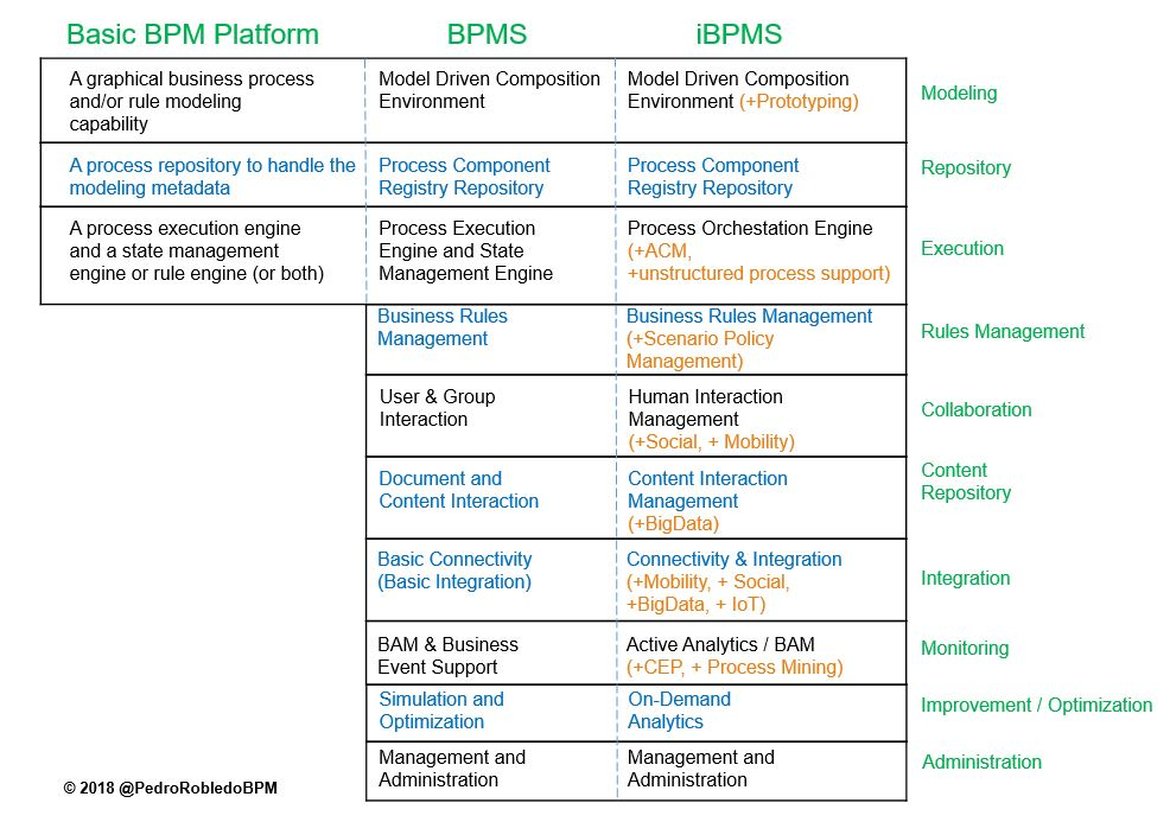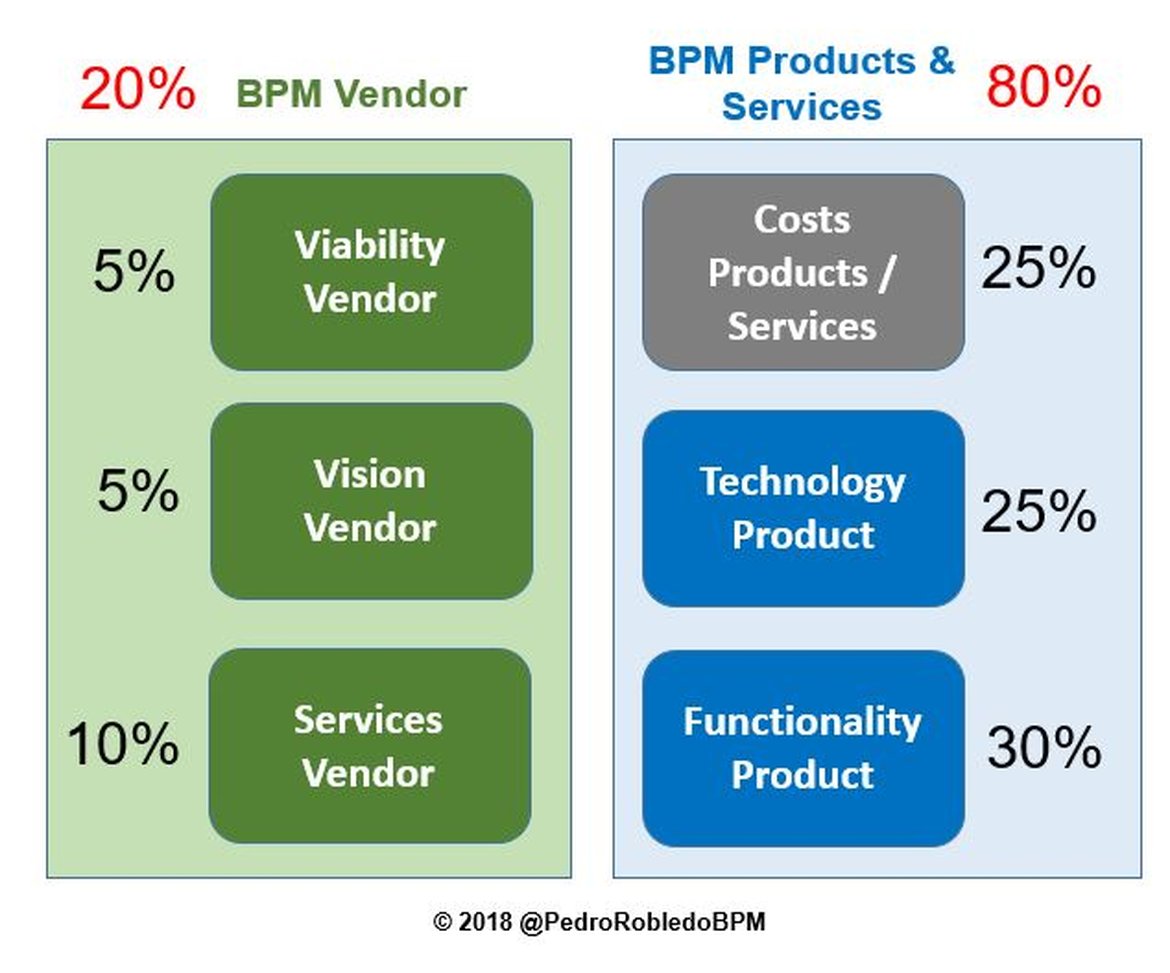¡HI! If you want to propose us a project, send a mail to info@albatian.com


ALL INFORMATION ABOUT
BPM, PROCESS, R & D, TECHNOLOGY
How to select a BPM software?
By: Pedro Robledo, BPM process management expert

The selection of software for the technological implementation of the Business Process Management (BPM) discipline will depend mainly on whether we want to cover the entire BPM life cycle or only some of its phases. The selection methodology explained below is valid for both cases, but when defining the evaluation criteria, it will be necessary to take into account what is the scope sought (with respect to the BPM life cycle), in order to evaluate similar products.
BPM Platforms
If what we are looking for is a BPM technology platform that covers most of the phase of the BPM life cycle for the continuous improvement of business processes, we have several types of platforms following Gartner's classification: basic BPM platform, BPMS (Business Process Management Suite) and iBPMS (Intelligent Business Process Management Suite). It will be essential to pay attention to the criteria that are evaluated in the analysis carried out by the analysts (Gartner, IDC, Forrester ...), so as not to rule out solutions that do not appear in these reports, because they could be adequate solutions for our requirements. Or, it can be considered a set of software solutions from different vendors that compliment each other (although both vendors and their future should be studied).
Figure 1 identifies the differentiating characteristics between the three types of BPM platforms classified by Gartner.

Figure 1. Differences between the 3 types of BPM Platforms
Process for the selection of BPM Platform
For the selection of the best BPM solution, a specific process must be defined that adjusts to assess how the solution responds to our specific technical requirements, but without ignoring other important criteria such as, for example, the future of the supplier and its situation in the market (it will be analyze later). When I advise on software selection, I recommend relying on the following process (high-level modeling in Figure 2) that includes three main phases:

Figure 2. BPM Software Selection Process
Phase 1. Define criteria for the selection and compile a list of potential suppliers
- Define RFP - Request For Proposal to make the selection, where all the necessary criteria are included to be able to evaluate a proposal. The hierarchy of criteria and sub-criteria for the selection is defined. It is necessary to weigh the criteria (quantitative and qualitative) to subsequently qualify the proposals. These considerations for the qualification of the proposals should be provided to the potential suppliers (so that they do not send proposals if they consider that they can not win). Result: Document Specifications and Evaluation Criteria.
- Send RFP to Potential Suppliers, indicating the deadline for reception of proposals.
Phase 2. Analysis of received proposals from potential suppliers
- Receive Candidates (responses to the RFP) until the deadline.
- Analyze Proposals and Select Final Candidates. The analysis requires evaluating the requirements and rating the proposals according to the criteria and weightings defined in the specifications. With the scores the final candidates must be selected (usually a maximum of 3 candidates). The selection can be based only on the score achieved (the maximum score) or also taking into account the conclusions obtained from the analysis of each candidate. Result: Document Previous analysis of suppliers and justification selection of 3 finalist candidates. And the script of the demo / prototype to be made by the finalists.
- Communicate the Finalists by providing the Demo or Pilot Guide. For the final selection the chosen candidates will have to carry out a demo or pilot (prototype) on a specific process, so it is necessary to provide them with the information required to be able to prepare the demo/pilot. In addition, the agenda offered to present it is provided.
Phase 3. Analysis solutions / finalists and select winner
- Perform Demo or Pilot with Finalists. Each finalist candidate will make a presentation through a demo of the solution or prototype developed ad-hoc. The finalists are provided with a script with the aim of marking the dedication and the topics they want reviewed the day of the demo of the solution offered. The demo / pilot seeks to verify the most important points in terms of the functionality of the solution, understand the steps to follow to implement the solution and understand the economic offer to resize the necessary architecture (licenses).
- Analyze and Compare the Finalists. The participants in the election analyze the Demo or Pilot made by each candidate giving him a reasoned score. Result: Comparative document of the solutions evaluated and conclusion of the solution with the highest score.
- Decide Provider. Initially, the decision will be based on the comparative document, but may require a final analysis of the Total Cost of Ownership (TCO) to compare the three solutions and consider the result of the analysis for the decision. And it is also possible to request a trial license to test the solutions for 1 to 2 months if it is necessary to compare some of the solutions of the finalists or to verify that the selected solution is suitable.
Definition of criteria for the selection of BPM platform
To understand which criteria can be included in the list of requirements to be weighted later, and thus qualify with arguments a BPM platform proposal, the reports of the main technological analysts can be used: Gartner, IDC, Forrester, Ovum and Info-Tech. I am going to review what each of the main analysts is based on, so that later each one can decide their own evaluation criteria.
- Gartner Group evaluates BPM vendors using the model of what it calls the Magic Quadrant that organizes vendors using a two-dimensional matrix that evaluates them based on their range of vision and their ability to execute. Gartner uses 15 criteria and classifies vendors into four categories: leaders (good now and good in the future), challengers (good now and unknown in the future), visionaries (bad now but good in the future) and niche players (niche and unknown in the future).
- IDC classifies the different vendors into four categories: participants, contenders, main players and leaders. And IDC bases its analysis on two axes: strategies and capabilities. And the MarketScape’s IDC reflects the presence in the market graphically.
- Forrester classifies the different vendors into four categories: bet with risk, contenders, strong executors and leaders. And Forrester bases its analysis on two axes: strength of current offer and strength of the strategy. And Forrester reflects the presence in the market graphically.
- Ovum classifies the different vendors into three categories: Leaders, Challengers and Followers. And Ovum bases its analysis on two axes: Technical evaluation and execution evaluation. Ovum also usually analyzes the vendors according to the impact on the market.
- Info-Tech classifies the different vendors into four categories: Champions, Market Pillars, Innovators and Emerging Players. And Info-Tech bases its analysis on two axes: Product Evaluation and Manufacturer Evaluation.
Each Analyst evaluates the BPM market with different concrete criteria (see figure 3), which can help in the selection of BPM software. But in each evaluation the selection will depend on the company's own requirements and how they align with what each vendor offers, so it will be necessary to define in the RFP the specific criteria necessary to carry out a correct evaluation.

Figure 3. Evaluation Criteria used by the main Analysts
In my consultancies helping organizations to select their BPM platform appropriate for their requirements, I suggest focusing on defining specific questions on 6 axes of study grouped into two main assessment groups:

Figure 4. Assesment axes of a BPM Platform
1. The vendor of the BPM solution (provider). Evaluating:
a) Feasibility of the Supplier, studying its geographical location (locally with its own office or through a distributor), company size, market share, organizational structure, product maturity, manufacturer's maturity, supplier's origin ...
b) Vision of the Supplier, evaluating its evolution as a manufacturer, product roadmap, number of versions per year, product offerings, investment in R+D+i ...
c) Services of the Provider, valuing their training services (On-site, Online, Free -Videos / MOOC / books / Manuals-, their consulting services (Implementation / Business / Technical ...), support services (online, local), 24x7, maintenance services…
2. The BPM product and services offered. Evaluating:
a) Costs Products and Services (Consulting, Support and Training), assessing the type of users needed (floating licenses - concurrent -, permanent licenses, by subscription); individual acquisition, packages, discounts...; annual maintenance costs; included version updates; support costs; installation cost; training cost; consulting cost; licensing: opensource, on-premise, public / private / hybrid cloud (saas, iaas, paas, bpaas); free 30 day testing tool ...
b) Product Technology, valuing Technology .NET / JAVA; Operating system (Mac OS, Windows, Linux, Unix ...); Language; Accessibility; Hardware Requirements; Software Requirements; Mobility; Connection Social Networks; Integration…
c) Product Functionality, studying the different necessary requirements that we want to comply with the BPM solution.
Each group will be weighted with a specific percentage depending on the importance that the evaluator considers. Figure 4 shows usual percentages. Specific questions will be included within each axis, marking the most important in red and the rest in black. The questions are qualified by a specific percentage depending on their importance, following this formula:
Points = [(∑red points x 8 / red questions x 5)+(∑ black points x 2 / red questions x 5)] / 2
To get 0 to 5 points
In this way, when evaluating all the candidates' proposals, the questions can be rated, getting a final grade for a solution, and making a decision based on the results.
RELACIONADO
-
Does your company have a Digital Culture?
by 4 Dec. 17, 2018
-
How to guide organizations in Maturity in BPM?
by 4 March 16, 2019
-
Where to learn BPM in the University?
by 4 Nov. 2, 2018
-
Differences between Processes, Procedures and Work Instructions
by 4 Dec. 7, 2017
-
Why BPM is vital for companies in the energy and utility industry
by Albatian July 13, 2020
-
Industry 4.0: the bpm challenge
by 4 July 9, 2017
-
Why BPM is Vital for Insurance Companies
by 4 Feb. 22, 2021
-
How to Calculate the ROI of a BPM Initiative?
by 4 July 9, 2017











